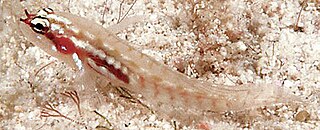
Eviota sigillata, commonly called seven-figure pygmy goby or adorned dwarfgoby, is a species of marine fish in the family Gobiidae. They are widespread throughout the tropical waters of the Indo-West Pacific area, from the Seychelles to the Micronesia.
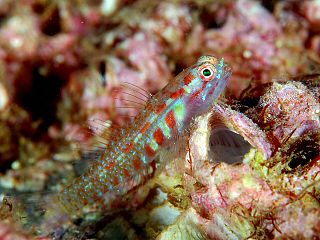
Eviota is a genus of fish in the family Gobiidae, commonly as dwarfgobies found in the Indo-Pacific region, where it is distributed from Japan to Australia and from Africa to Pitcairn Island. Species are mainly associated with coral reefs. Many of these fish are short-lived, with life cycles as brief as 3.5 weeks in the tropics. Some species are hermaphrodites and some representatives live symbiotically among the tentacles of the mushroom coral.
Eviota readerae is a species of goby associated with reefs and tide pools. It has a very limited distribution in the southwest Pacific, being found only on the Elizabeth and Middleton Reefs and the Lord Howe Rise in the Tasman Sea.
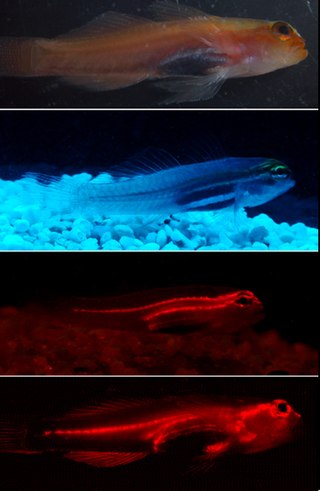
Eviota pellucida, commonly called neon pygmy goby or pellucida pygmy goby, is a species of marine fish in the family Gobiidae.

True gobies were a subfamily, the Gobiinae, of the goby family Gobiidae, although the 5th edition of the Fishes of the World does not subdivide the Gobiidae into subfamilies. They are found in all oceans and a few rivers and lakes, but most live in warm waters. Altogether, the Gobiinae unite about 1149 described species in 160 genera, and new ones are still being discovered in numbers.
Sueviota is a genus of fish in the family Gobiidae native to the Indian and Pacific Ocean.

Trimma is a genus of fish in the family Gobiidae native to the Indian and Pacific Ocean. Together with members of the genus Eviota, they are known commonly as pygmygobies or dwarfgobies.
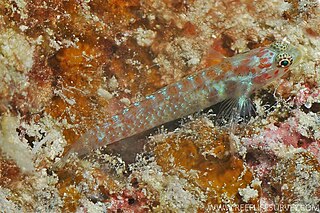
Eviota melasma, commonly called headspot eviota or melasma pygmy goby among various other vernacular names, is a species of marine fish in the family Gobiidae.

Trimma nasa, commonly called the nasal dwarfgoby or nasal pygmy goby, is a species of goby from the Western Pacific. They are small fish, averaging at around 2 cm (0.79 in) in length. They are bright orange and transparent yellow in life, with a white stripe running down from between the eyes to the upper lip and a dark brown spot at the base of the tail fin. They are usually found in large schools in the sloping or vertical drop-offs at coral reef edges.
Trimma tevegae, commonly known as the bluestripe pygmygoby or blue-striped cave goby among other names, is a species of goby from the western Pacific. They are small fish, averaging at 2 cm (0.79 in), orange-brown with white undersides in life, with characteristic iridescent blue or lavender stripes on the sides and on top of the body. They are usually found in large schools in the sloping or vertical drop-offs at coral reef edges. They are sometimes caught for the aquarium trade, and are also known by hobbyists under the name blue line flagtail goby. The species is named in honor of the schooner Te Vega.
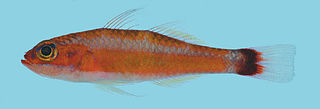
Trimma caudomaculatum, the blotch-tailed pygmygoby , is a species of goby from the Western Pacific. Like other members of the genus, they are usually found in large schools in the sloping or vertical drop-offs at coral reef edges. Similar to other species of Trimma this species consists of multiple cases of bidirectional sex change, meaning that if a group is lacking in a specific sex a partial amount of the group can change their undeveloped gonad structure of the opposite sex in order to accommodate. This sex change is made possible due to the females having a developed set of ovaries with female hormones that are developed, and a set of testis and male hormones that are underdeveloped; The males follow a similar set up in vice versa, so their testis and male hormones are developed, while the ovaries and female hormones are underdeveloped.
Eviota guttata, the spotted dwarfgoby, is a species of ray-finned fish from the family Gobiidae, the "true gobies". It is found in the western Indian Ocean.
Helen K. Larson is an ichthyologist who specialises in the fishes of the Indo-Pacific.
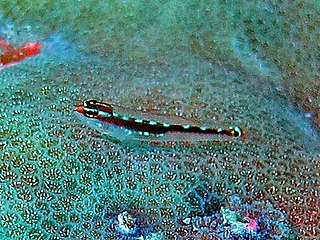
Eviota sebreei, common name Sebree's pygmy goby or striped dwarfgoby, is a species of fishes belonging to the family Gobiidae.
Sueviota bryozophila the bryozoan goby, is a species of fish in the family Gobiidae. It is found in Indonesia.
Sueviota tubicola, the tubeworm dwarfgoby, is a species of fish in the family Gobiidae. It is found in Papua New Guinea.

Sueviota aprica, the sunny dwarfgoby, is a species of fish in the family Gobiidae. found in Indonesia.This species reaches a length of 1.4 cm (0.55 in).
Sueviota atrinasa, the blacknose dwarfgoby, is a species of fish in the family Gobiidae. found in the Indo-West Pacific Ocean.
Sueviota lachneri, also known as Lachner's dwarfgoby, is a species of fish in the family Gobiidae. found in the Maldives.
Sueviota larsonae, also known as Larson's sueviota, is a species of fish in the family Gobiidae. It is found in the western-central Pacific Ocean.









